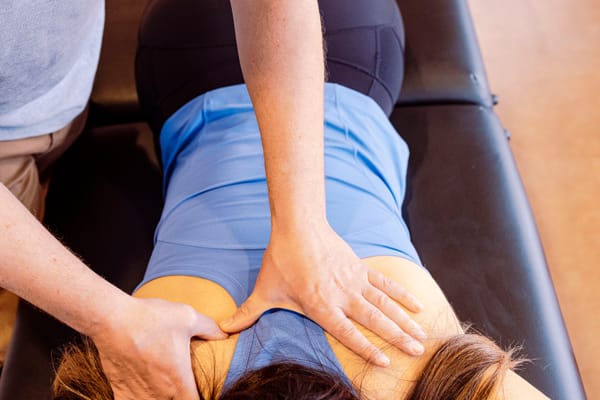
Shoulder Pain - Trigger Point Therapy
To understand the role of trigger points, you can imagine your muscles are a garden hose.
Trigger Point Therapy for Shoulder Pain
Trigger point therapy has shown promising results in treating severe pain in the shoulder, as evidenced by various studies and clinical observations.
A notable clinical trial published in the Journal of Bodywork and Movement Therapies (Vol. 21, Issue 4, 2017, Pages 920-926) explored the effectiveness of this therapy on patients with chronic shoulder pain.
The study found that participants who received trigger point therapy experienced significant reductions in pain and improvements in shoulder mobility. This indicates that targeting specific trigger points can effectively alleviate discomfort and enhance joint function in individuals with chronic shoulder issues.

What makes this finding particularly compelling is the focus on chronic pain—a condition often resistant to conventional treatments. The study highlights that trigger point therapy, similar to that used in Iler Method® Therapy, provides immediate pain relief and contributes to long-term improvements in shoulder function.
This is especially relevant for those seeking alternatives to medication or invasive procedures. By offering a non-invasive, drug-free approach, trigger point therapy, as practiced in Iler Method Therapy, emerges as a viable and effective option for resolving and managing chronic shoulder pain.
What are Trigger Points?
To understand the role of trigger points, you can imagine your muscles are a garden hose. Water flows smoothly when the hose is free of knots, and everything works well. But if there's a knot in the hose, the water flow gets disrupted, and it might even cause a bulge or increase the pressure in another part of the hose.
Trigger points in your muscles are like these knots. They are spots that can become tight and painful, often due to stress, overuse, or injury. When these points get knotted up, they can cause pain and tension not just at that spot but also in other areas of the human body.
Like a gardener who carefully untangles those knots, a licensed massage therapist uses specialized techniques to find these trigger points and apply the right amount of pressure to relax them.
This process helps to restore normal muscle function and relieve pain. It's like smoothing out the kinks in the hose so everything flows smoothly again. The goal is to reduce pain and improve overall muscle function, like ensuring a well-maintained and knot-free garden hose.

Where are Shoulder Trigger Points?
Trigger points in the shoulder typically arise in areas like the supraspinatus muscle, levator scapulae, infraspinatus muscle, and sternocleidomastoid attachments of the neck. These points can cause pain in the immediate and surrounding major muscles when aggravated. The pain may even radiate down the arm or into the neck in severe cases, depending on the affected muscle and the density of the trigger point.
In treating these trigger points, my role as a massage therapist is to carefully locate these areas through palpation and apply specialized firm pressure techniques such as deep tissue massage or myofascial release.
Key Benefits of Trigger Point Therapy for Shoulder Pain
- Alleviates Pain: This therapy is particularly effective in diminishing shoulder pain by directly addressing the source of discomfort. It also tackles referred pain, often in areas distant from the latent trigger points, providing full-body pain relief.
- Non-Invasive Treatment: It offers a drug-free alternative to pain relief without the risks associated with surgery or long-term medication use. It's great for clients seeking a holistic approach to managing shoulder joint problems.
- Promotes Healing: Trigger point therapy accelerates the healing process of muscle injuries by targeting and releasing deep-seated tension in specific muscle groups. It's a practical component of a comprehensive rehabilitation program, complementing other treatments to enhance overall recovery.
Relieve Neck and Shoulder Pain with Iler Method Techniques
Like traditional trigger point therapy, this method targets specific muscle tension and tender points contributing to discomfort in these regions.
The Iler Method releases various shoulder and neck muscles by applying precise pressure and manipulative techniques.
The following techniques reduce muscle tension, alleviate pain, and improve the range of motion and flexibility in the neck and local points of the shoulder areas.

Straight fingers -
In trigger point therapy, using two or more straight fingers, typically the middle and ring fingers allows for precise pressure application on muscles like the levator scapulae, trapezius, teres major, and minor.
This technique effectively targets fine trigger points and adhesions. It starts with short durations of 5-10 seconds and gradually increases as the muscle tissue warms up to address deeper acupressure points.
Hand and Fingers over Fingers -
This technique applies balanced, amplified pressure to deeper, hard-to-access active trigger points in areas like the neck muscles, trapezius, and teres, major and minor.
By placing one hand over the opposite hand, this method allows the top hand to add pressure to the bottom hand's fingers, combining force with sensitivity for effective treatment.
Thumb Over Thumb -
This technique works effectively on dense, multi-layered soft tissues in areas like the shoulder muscles of teres minor and major, neck, and upper trapezius muscles.
By using one thumb pad to apply pressure over the other, this technique not only increases the amount of possible pressure but also reduces the risk of injury to the therapist's thumb joint, making it a precise, effective, and safe tool for deep tissue for the therapist and client.
Final Thoughts: Trigger Points for Shoulder Pain
In today's discussion, we focused on the significance of treating trigger points to alleviate muscle pain, particularly in areas such as the levator scapulae, trapezius, and teres muscles. Trigger points, or tight spots in the muscles, can cause extensive pain and tension throughout the body.
Addressing these points effectively can lead to significant relief and improved muscle function. The importance of specialized methods like the Iler Method® in managing such muscular discomfort was also highlighted.
This approach for treating muscle-related discomfort, especially in the neck and shoulder areas, emphasizes immediate pain relief with non-invasive treatment that promotes long-term healing.
Trigger Point Therapy for Shoulder Pain: FAQs
Is there a pressure point to relieve shoulder pain?
Trigger Point Therapy effectively uses pressure on specific areas to relieve shoulder pain by targeting and releasing muscle tension and improving overall health.
Where is the trigger point for releasing the shoulder?
Yes, the trigger point for releasing shoulder pain is typically in muscles like the trapezius, levator scapulae, and the rotator cuff area.
How can I get immediate relief from shoulder pain?
Trigger point therapy can immediately relieve shoulder pain by targeting specific knots in muscles like the subscapularis muscle near the shoulder blade, trapezius, and levator scapulae.
Can trigger points cause shoulder pain?
Yes, trigger points in muscles such as the trapezius and levator scapulae can cause shoulder joint pain, although this discomfort is typically temporary and can be alleviated with proper treatment.
Is trigger point therapy good for you?
Yes, trigger point therapy is an effective massage that targets and relieves major trigger points, reducing pain and improving the health of the rotator cuff muscles.
Disclaimer -
Please note that at Iler Method® Therapy, we specialize in massage therapy and related techniques. All clients must understand that we are not medical professionals, and our services should not be seen as a substitute for medical advice, diagnosis, or treatment. Our practices are designed to support and complement your overall health, but they do not replace professional medical consultation when needed.




